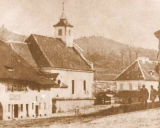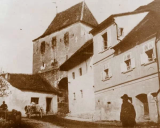old town [story introduction]
December 6, 2011 § 3 Comments
I’ll start by presenting to you some photos of the old town, just to get you accustomed with the surroundings:
Mind you, these are very old photos. The town today is much bigger, has around 35,000 people, is a modern town, in which you can find everything you would be able to find in any other European town… and much more.
A bit of history: Sighisoara is an old town, very old, it has only been mentioned historically, in writing, in findings of texts that dated the town back to around 1200 but the town existed long before that.
This whole area, Transylvania and what is the modern-day Romania has been inhabited by people and animals for a long, long time.
Romania, as a name for a country, is relatively new – but the area and the people who inhabit these lands – are as old as time.
You don’t have to believe me, see for yourself here. That is a BBC news article which presents a team of scientists who found the oldest human remains in Europe in a cave in modern-day Romania.
So you see, by definition – you’re all Romanian. Well, not culture wise, but blood wise, genetically, we’re all much closer related than you would think – I’m speaking here to those who consider themselves of European descent.
Vikings, Americans, French, Dutch, German and any other European descendants you can think of – you are all, at your core – Romanian. Like it or not, your ancestors are from the woods of Transylvania.
You would think: “Well if you put it that way, we’re all African.” – Well yes, and no. You see, after Africa, races separated and mutated. At a genetic level, these bones are the closest to the MODERN human being in Europe. In other words, if you go further back, it’s no longer regarded as Homo sapiens of Europe.
So yes, we are all African, but the white race, Europeans, they were first drawn to that particular place. Romania. That’s from where they started off in different directions.
But enough with the science lesson.
As I was saying, the land is inhabited since the dawn of our time, as a race. Bottom point: it’s really old. Rome is nothing compared to it. Rome and Athens were deserted places when these areas flourished with human life.
Sighisoara as a town may be dated to around 1200 but the area was inhabited way before that, for tens of thousands of years.
The town is the birth place of Vlad the Impaler, also known as Dracula, which by all means, was a real person, a ruler who apparently drank the blood of his enemies. Pretty straight forward if you ask me.
He was, historically attested in German books, as seen drinking the blood of his enemies (Turks who invaded Valahia, part of Romania) – let me ask you this: have you ever tried drinking blood? If you didn’t, then don’t. If you did, then you know that you can’t really drink more than 100ml before puking. The human digestive system is not equipped to digest blood – it is simply not digested, it’s like eating plastic, actually even worse. The enzymes you have in the stomach cannot break down the blood and you end up puking it. Even with training, it’s hard holding in more than 200mg before getting sick to your stomach.
Dracula however, apparently, had no problems chugging loads of blood, but he was not only a ruler. He was the most cruel ruler Romania has ever seen, he managed to turn back armies of over 20.000 people without even speaking to them. He was so cruel that the Turks, which were considered the most savage at the times by the Germans, actually refused to go to battle with him and stopped invading the country as long as he was alive.
Cool story right? Right.
Well let me tell you something more about Dracul, things you might or might not find in other books. And you’d better believe this, because it’s true. This is not fiction, not invented, not exaggerated. It’s actually common knowledge back home.
Dracula, for example, is a name which he took from his father, who was a member of the “Dragon” order, and at that time the Romanian language translated “dragon” into “drac”. As such, “dracu” means “the dragon”, we use the “the” as an “u” which we put at the end, and not as a word (“the”) in the beginning. In other words, “the” = “u” – as a termination, in the Romanian language. That’s why “drac” = dragon and “dracu” = the dragon.
The word “Dracula” is formed by that and by the “la” termination, which together with “u”, thus “ula” forms a modern termination, which is the same with “ulea” (added e). Last names ending in “ulea” were common and popular in those times. That’s how “Draculea” was born, and, after a while, as the Romanian language dropped the added e, the word Draculea also transformed into Dracula. It’s pretty simple. Drac equaled dragon and Dracula is just that, but with a termination used in last names.
Wanna know another interesting thing? Dracula was so cruel that nowadays, the word “drac” doesn’t mean dragon anymore, it literally means “devil”, and “Dracu” literally means “the devil”. There is NO OTHER Romanian word for the devil except “Dracu”. That’s how cruel he was. His name is now not only synonymous with “devil” but is actually the only way of saying “devil” in Romanian.
You could use “Satana” also, but that’s not Romanian.
And if you’re wondering so how are you calling “dragon” then, well, we adopted “dragon” also, so today a dragon is exactly how it is in the English language.
OK so far?
Good, more about Dracula in this post. Now back to the town.
If you read up until now, there’s a small chance that you’re interested in vampires and whatnot. Maybe you’ve read The Vampire Diaries, the book, which is utter bullshit, except one thing.
It speaks about some sort of lines of power which go under the town and apparently that’s the reason creatures gather there.
This is really interesting, and I wonder how did the author guessed or invented this, or why.
Why am I talking about these lines of power – whatever they are?
Well, old tales which you could only find in the town itself, from old people, and from some documents which got lost a couple of times but apparently you can now ask to read, those old tales tell of the town being built specifically there by orders of a demon. A myth say the people.
We’ve always considered these to be just that, tales – Demon? Ordering the building of a town? That is ridiculous. The demon is described as being a “black eyed child” – black eyed as in completely black, no white of the eye, no nothing, just pure blackness, which was the child of a local, procreated with by a Roman settler, the general.
That Roman settler built a fort there, named “Castrum Sex” in Latin that means “Fort Six”, he was the general of a Roman Legion which had settled in Romania after it was invaded by the Romans – this is historically attested. The Citadel of Sighisoara was built later on, centuries after, on and around the walls of an old Roman fort which still had the inscription visible, “Castrum Sex” or “Fort Six”. The tablet dated the fort back to being completed in the year 66 A.D.
This is rather interesting? How is this interesting? Well for one, it was the fort number 6, built in the year 66. And then again, Dracula, whose name means “The Devil” was born there.
You might think this is “stretching it” – which by all means, it might be – but it doesn’t change the facts. These are true, historically attested, in original paperwork, facts.
He was born there, his name does mean the devil, the fort was the sixth, and it was built in the year 66.
All this stretches over two millenia, and yes, it’s hard to comprehend – but the bottom point is – the myth lives on, the general built the fort because his child – made with a local girl – ordered it. The child had deep, black eyes, everybody feared him and he eventually vanished, but his father did do what he was told: he built the fort in a specific spot.
The same legend also talks about the spot as being the crossing point of different lines of power. Nobody really knows what kind of power that might be, but apparently the more lines of power cross, the stronger is the attraction of power-hungry creatures, and a gateway can be created (towards where?) in the center of the crossing.
That’s all about the town for today,
Go now and check for what I’ve said here online.
I found some of the things online, but then again I know them all by heart as well as you know the history of your own home town.
Related articles
- Romania – country profile (rombizco.wordpress.com)
- Impressions Of Romania: From Transylvania To Bucharest (wanderingearl.com)
- Prince Charles To Be King Of Romania (merovee.wordpress.com)
- Tales From the Golden Age ~ (Romania, 2009) ~ Netflix (chazzw.wordpress.com)
- Amid myths, in search of Dracula’s real castle (sfgate.com)














